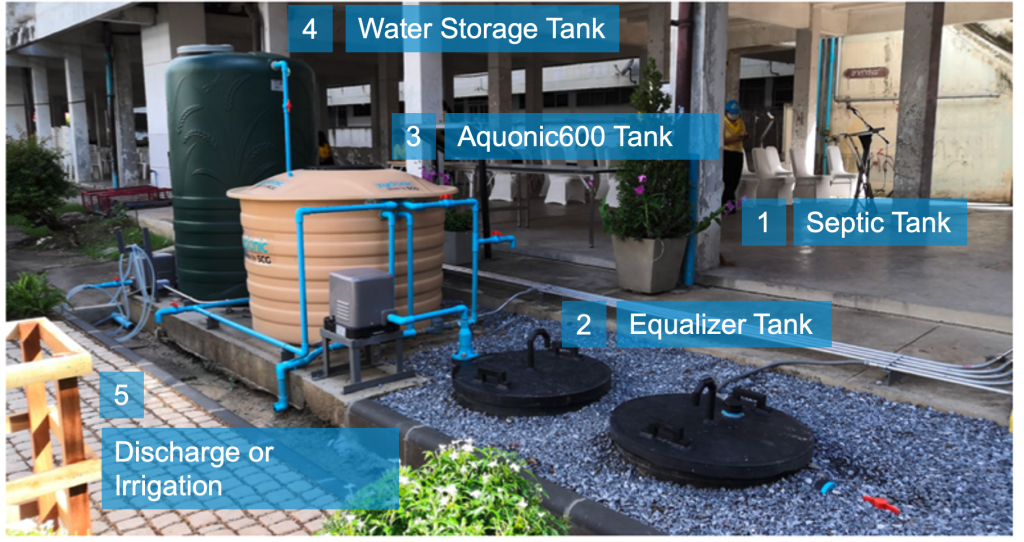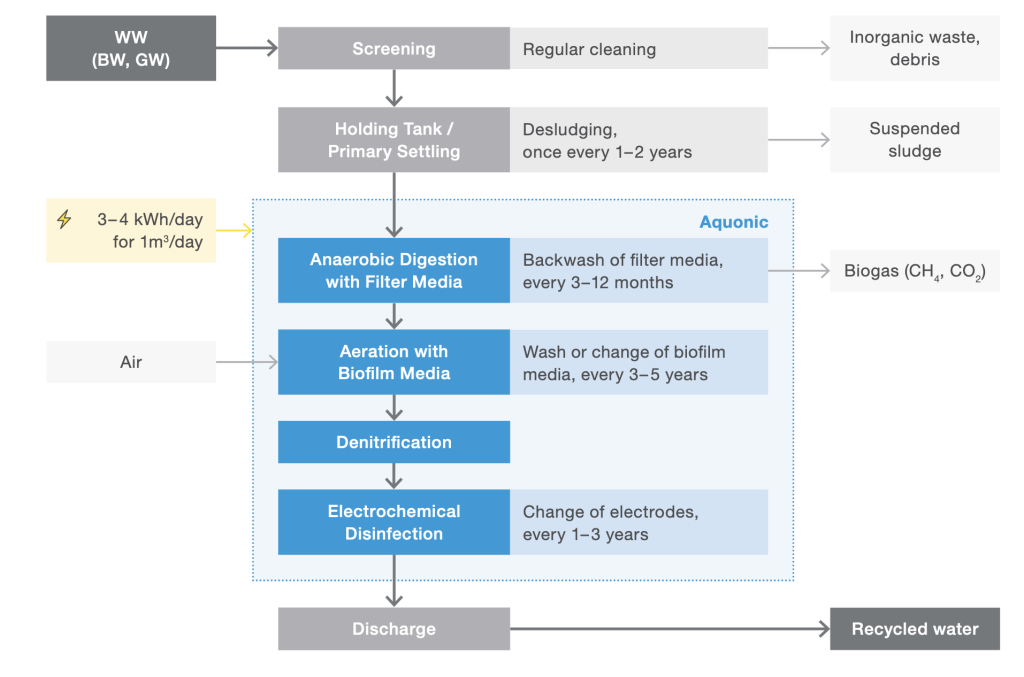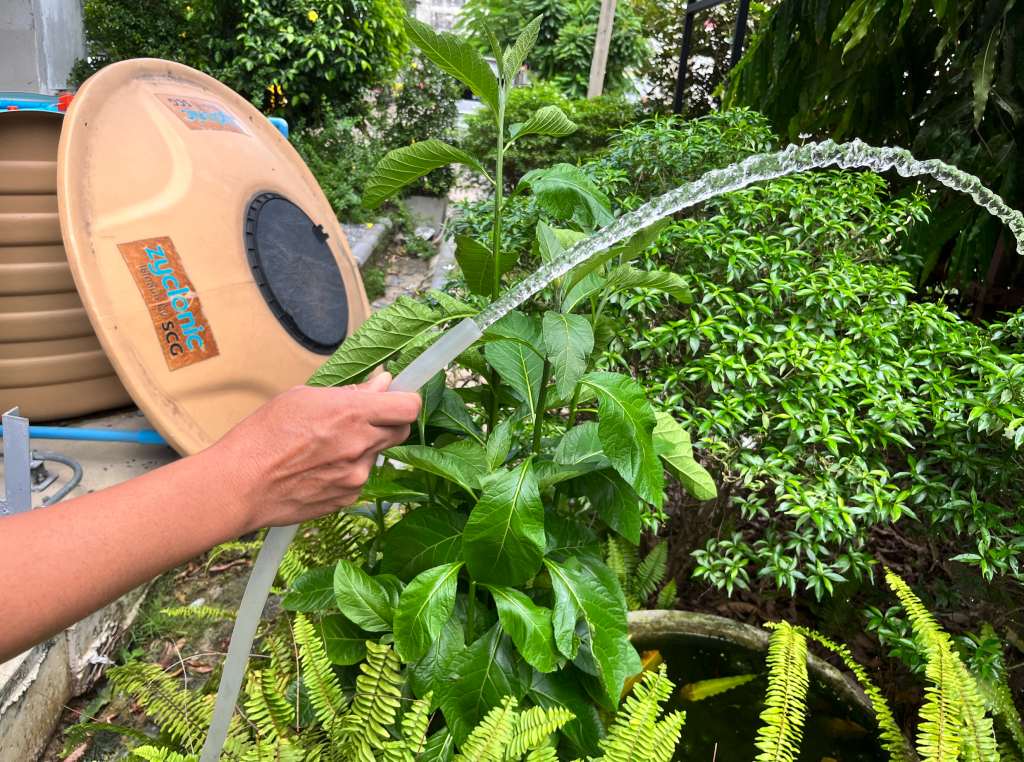6.3 SCGc Back-End Technologies
SCGc offers a range of advanced modules for back-end technologies. However, we will focus on the Aquonic Tank that treats wastewater or effluent.
Aquonic Tank comprises various compartments for removing organic load, denitrification, and disinfection. This innovative tank can transform septic effluent, greywater, or pre-treated wastewater into pathogen-free, reusable water suitable for toilet flushing and irrigation.

The Aquonic Tank was developed by SCG Thailand and is a prefabricated treatment unit available in two capacities: 0.6 m³/d and 1 m³/d per unit. These units are modular in design, allowing for flexibility in configuration to meet specific treatment requirements.
The Aquonic Tank can effectively treat various wastewater sources as a secondary treatment step and be easily integrated after the initial solid and liquid separation or as a treatment stage following biological pre-treatment, such as a septic tank. The possible setup for this treatment process is illustrated below.
6.3.1 How does the system work?
The Aquonic wastewater treatment unit is a patented system that offers a complete solution by incorporating various biological treatment steps. These steps include anaerobic and aerobic treatments, an anoxic process, and electrochemical disinfection as the final step.

Here is how it works.
Anaerobic Treatment: This process operates without oxygen, creating an anaerobic environment where specialised microorganisms are anchored to filter media. Their primary function is to remove organic pollutants and reduce the overall load, converting it into methane and carbon dioxide. This step effectively breaks down organic matter.
Aerobic Treatment: In this phase, the treatment occurs in the presence of oxygen. Aerobic microorganisms, also attached to filter media, utilise oxygen to degrade organic compounds further and convert them into carbon dioxide, water, and biomass.
Anoxic Treatment: Anoxic treatment occurs in an environment with low oxygen levels and employs facultative microorganisms capable of functioning both in the presence and absence of oxygen. These environmental conditions promote the growth of specific microorganisms responsible for denitrification. During denitrification, nitrates and nitrites are transformed into nitrogen gas. This is crucial in eliminating excess nitrogen from wastewater.
Electrochemical Disinfection: This is the last step of the treatment process and uses electrochemical reactions to effectively eliminate or inactivate microorganisms such as bacteria, viruses, and other pathogens. This step ensures that the treated water meets high standards of disinfection and safety, making it safe for reuse or discharge.
6.3.2 Treatment Performance

The Aquonic unit is widely recognized for its ability to produce high-quality effluent that meets ISO standards and is free of pathogens. The resulting effluent is safe for reuse in irrigation or toilet flushing.
6.3.3 Space Requirement
The installation of each Aquonic tank unit requires only 2 m² of space, making it a great option in locations where space is limited or expensive. The modular design of the Aquonic unit provides flexibility in configuration, making it adaptable to various installation environments.
6.3.4 Energy Requirements
The Aquonic tank unit requires approximately 3 kWh of energy per day, which could be supplied by photovoltaic (solar) panels.
6.3.5 What are the O&M Requirements?
A trained technician is needed for the system maintenance. The maintenance tasks depend on the treatment needs and the influent strength. The tasks include:
- Backwashing of the filter media
- Replacement of electrodes
- Washing or changing of the filter bio-media
The connected toilets can operate during maintenance because of the buffer capacity of the septic/holding tank.
6.3.6 What are the Benefits and Limitations?
The following table outlines the benefits and limitations of the SCGc Aquonic Tank.
| Benefits | Limitations |
|---|---|
| Small footprint | Regular maintenance is required |
| Suitable for retrofitting of existing systems | System will require a start-up phase if stopped for over 6 months |
| Closed, watertight system that does not produce any odours or sounds in normal operation | The electronic and electrical system needs protection against water |
| Moveable and easy to install | Requires electricity for operation |
| Automated treatment | Has to be aboveground or in an accessible subsurface enclosure (e.g. building basement) |
| Can treat low and high-strength wastewater | |
| Can be stopped and started without affecting the performance of the system | |
| Pathogen-free effluent |
6.3.7 Examples
Please visit the following virtual tours for the project details:
- Community Toilets in Klong Plub Plan, Bangkok, Thailand (Link)
- Public Toilet, Putthamonthon Park, Bangkok, Thailand (Link)
For further information on SCGc back-end technologies, please click on the Materials tab at the top of the page.
Further Reading:
- Zyclonic™ : An Innovation in Wastewater Treatment and Reinvented Toilets for Social Sustainability (Link)
